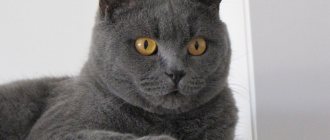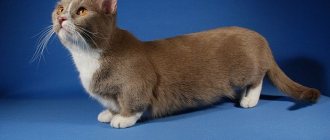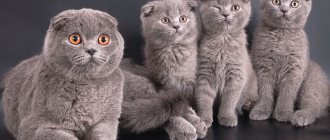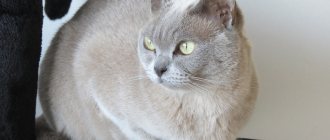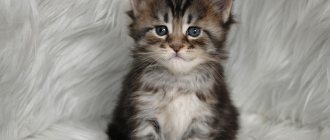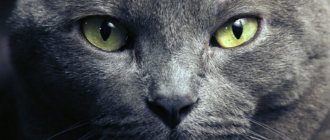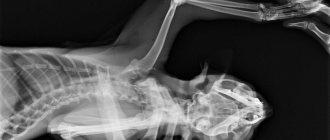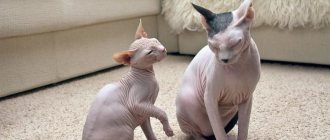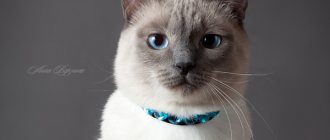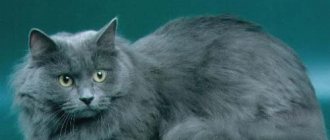Brief description of the breed and distinctive features
Distinctive features of representatives of this breed: thick hair, powerful build, large size, strong bones and a pubescent, very fluffy tail. Their weight is approximately 8-10 kilograms .
These individuals have a rounded head and a short, powerful neck. The ears are set high, pointed, and if you look closely you can see the tassels. Also, representatives of this breed have thick and long mustaches. The hind legs are slightly shorter than the front legs and their muscles are well defined.
Appearance of the Norwegian Forest Cat
Norwegian Forest Kitten
The size of the Norwegian Forest Cat ranges from medium to large. Like other large breeds, they reach final maturity quite late - at 4-5 years. Animals appear more massive due to their thick fur. The exact height and weight indicators are not indicated by the WCF breed standards, but experienced breeders say that the norm for an adult is a height of 30-40 cm, weight depends significantly on gender: cats weigh on average 5.5 kg (although graceful 4-kg cats are often found ladies), and males reach 6-9 kg.
Head
In the shape of an equilateral triangle, the outlines are smooth, the profile is straight, without a “stop”, the forehead is high and almost flat. The cheekbones are not pronounced, geometrically straight and long. The nose is of medium length, almost always pink. The jaws are powerful. The chin has a square or round outline.
Eyes
The eyes of the Norwegian Forest Cat are large and expressive. They have an oval or almond shape. Placed a little askew. The preferred color is green, gold and shades thereof, although other options are not considered a disadvantage. In white cats, heterochromia (eyes of different colors) is allowed.
Ears
Medium in size, with a wide base and slightly rounded tips on which “tassels” are desirable. Set high and wide on the head, the outer edge continues the line of the head. The inside is covered with long hair.
Neck
Medium length, flexible, well developed muscles.
The muzzle of a Norwegian forest cat
Body
Red Norwegian Forest Cat
The body of the Norwegian forest cat is large, powerful, and relatively long. The bones are strong, heavy, the muscles are dense and well developed. The chest is round and wide. The back of the body is above the shoulder line.
Limbs
The front ones are of medium length and powerful. The hindquarters are significantly longer, athletic, the thighs are strong and muscular.
Paws
Round or oval, wide. The toes are well developed, with thick tufts of hair located between them.
Tail
Flexible and long - when bent, it reaches the line of the shoulders or neck. Placed high. Wide at the base, somewhat tapering towards the tip, always fluffy.
Wool
Semi-long, thick, with a fluffy and moderately wavy undercoat. The outer hair is smooth and has a water-repellent effect due to its oiliness. Because of this feature, the Norwegian Forest Cat's coat can look a little unkempt. The length depends on the location: the shortest hairs on the shoulders and back gradually lengthen, turning into a spectacular “collar”, “bib” and “pants”. The degree of expression of such decorating fragments may vary and is not strictly regulated by the rules.
Color
Norwegian forest cat tortoiseshell color
Can be solid, bicolor, shaded, smoky, tabby. In general, 64 color variants of Norwegian forest cats are recognized, but the list depends on the specific organization. Thus, the International Federation does not allow light brown, yellowish-brown and shades that are characteristic of Burmese cats, but considers white in any variations to be the norm. And the French Central Society of Cat Fanciers (SCFF) outlaws chocolate, lilac Stogcatts and color-point cats.
Flaws
Sizes too small. Insufficiently strong bones. Poorly developed muscles. Square body. The head is square or round. A profile with a “stop”, that is, a transition from the forehead to the rest of the muzzle with a pronounced depression. Small or round eyes. Small ears. Short legs. Short tail.
Disqualifying Faults
The coat has a silky texture, is dry or matted. Amputated claws, deafness, location of the testicles outside the scrotum.
What does the price depend on?
- Pedigree . First of all, the price of any individual (in qualified nurseries) depends on the pedigree. For example, if the kitten’s parents participated in various exhibitions and took places, then their kitten will accordingly cost more than the one whose parents have a less vibrant and voluminous pedigree.
- Floor . A female will be slightly cheaper than a male.
- Purpose . It depends on what purpose you are purchasing the animal for. There are two options: either as a pet, or for exhibitions and further breeding. Then you need to look at what class the cat belongs to (described in more detail in the next paragraph) and look at the prices.
- Age . The point is quite important, since most often grown-up individuals are sold cheaper than kittens (2.5-3 months)
- Color . This is also an important point that affects the cost. Rarer colors tend to be more expensive than common ones.
Class
There are three classes of kittens: Pet-class, Breed-class and Show-class:
- Pet class is the lowest of all classes. Such kittens least of all correspond to breed standards or have any deviations. For example: incorrect coloring, coat type (too long or vice versa). Such kittens are suitable only for home keeping, but not for exhibitions. They can be purchased at a much lower cost.
- Breed class - middle class. Such individuals have only a slight discrepancy with the standard. They are suitable both as a regular pet and for exhibitions and shows.
- Show class is the highest class among all. These representatives meet all breed standards and are intended for breeding and exhibitions only.
About Us
Hello.
My name is Mikhnevich Ksenia. And I am glad to welcome you to the website of our nursery “Fashion Peak”.
The nursery was officially registered under the WCF system in 2011, but the first cats appeared with us much earlier.
At that moment, we could not even imagine that our boundless love for this amazing breed would force us to plunge into the cat world called felinology.
Currently, Norwegian Forest cats are very popular in Europe and are represented in almost all countries of the world. They attract attention and arouse interest at any cat show.
Predictions about the great future of these cats in Europe have already come true: at European exhibitions this breed takes first place in the ranking in terms of the number of animals exhibited.
In Russia, the number of animals is small, but interest in them is growing and, we are sure that in the near future at Russian cat shows it will be possible to see the entire diversity of representatives of this unique breed, and not just single specimens, as at present.
And that is why our nursery is called “Fashion Peak”, which means “At the peak of fashion”.
To popularize the breed and increase its recognition, we take part in exhibitions that are interesting to us, not only in Novosibirsk, but also in other cities, where we communicate a lot with visitors and breeders of our and other breeds.
At all exhibitions, the animals of our nursery and our graduates show excellent results. More detailed information about the exhibition results can be found here.
We are not chasing high titles, we are not chasing points in ratings. For us, the health, breed qualities, character of our animals and the kittens born to us are much more important.
Our cattery has repeatedly sponsored the Specialty Show of Norwegian Forest Cats “Wild Charm”. Photos from the Show can be seen here, here and here.
The 7-8 issue of 2013 of the magazine "Cats.info" was dedicated to Norwegian Forest cats, and it is very pleasant that the cover of the magazine was graced by a graduate of our nursery Baloo On Fashion Peak, who currently lives and continues a successful exhibition career in Odessa, and in the article photographs of animals from our nursery and our breeding were used.
The 8th issue of 2013 of the magazine “My Friend CAT” was also dedicated to the Norwegians; we were able to talk about this wonderful breed, as well as the prospects for its development.
In the photo album of cat breeds, released by the editors of "Cats.info", in the information section about Norwegian Forest cats, our cat Afanasij On Fashion Peak, our Litter E... On Fashion Peak and Cleopatra Ejvind*BY are presented.
We approach breeding from a scientific point of view, refer to professional publications, and are interested in new ideas. We successfully completed felinological courses with different teachers. We attend various seminars and strive to deepen our knowledge in matters of felinology. More detailed information on this issue can be found here.
Our nursery presents males and female cats of excellent breed type from the best breed lines in Europe, the level of which has been repeatedly confirmed by victories in numerous exhibitions, shows and rings. Our animals have gorgeous wool, which we are rightfully proud of, because luxurious and specifically Norwegian wool is very rare at the moment!
All our cats live next to us, they are sociable, sociable, have a balanced character, and get along well with children and other animals. They receive high-quality super-premium food, are regularly vaccinated, and undergo deworming.
Our animals have access to equipped enclosures in the fresh air, where they can soak up the sun, as well as run and play to their heart's content. The enclosure has a warm heated room, so outdoor recreation is possible even in winter.
In our nursery only PURE BREED adult animals and kittens are presented for sale. We are ready to tell you all the information you are interested in about each of them.
We DO NOT sell animals at Bird Markets.
Kittens leave the nursery no earlier than 3 months, accustomed to the toilet and scratching post. All our kittens have documents of origin: birth certificate or pedigree, veterinary passport with notes on all vaccinations.
We do not skimp on the health of our animals; kittens are vaccinated only with imported vaccines, which ensure the formation of excellent immunity!
The kitten goes to its new home with a supply of its usual food, favorite treats, toys and a guide booklet on raising kittens.
If a kitten is purchased as a pet, it will be spayed/neutered before moving to a new home. You can read about the benefits of sterilization here.
We try to maintain relationships with all the owners of our kittens; they can all contact us at any time with any questions regarding the health and behavior of the kitten.
The geography of our graduates is constantly growing: Novosibirsk, Kemerovo, Barnaul, Moscow, Ufa, Odessa... Together with you, we can choose the optimal way to deliver your baby to your city. We will prepare all the necessary documents and attributes for the kitten’s travel.
On the pages of our website you can find information about the breed of Norwegian Forest cats, information on how to choose the right kitten and why you need to castrate/sterilize your pet, you can see the males and female cats of our cattery, our graduates who continue their exhibition careers, get acquainted with the kittens , presented for sale, and much other information.
Professional photographs of our animals were taken by Andrey Medvedev, Yuri Kuzmin and Yulia Vakulenko.
We are always open to communication and new ideas!
And we are sure that this breed will not leave you indifferent!
You can see our contacts here. We will be glad to communicate!
Best regards, Ksenia.
Health and disease of the Norwegian forest cat
Natural selection, which determined the development of the breed for several centuries, led to the formation of a strong and healthy population. Of course, recent human intervention - selective breeding, a limited number of genetic lines - has had negative consequences, but in general, Norwegian forest cats remain strong and hardy. They are at risk of only a few serious diseases:
- restrictive cardiomyopathy – decreased compliance of the heart muscle and subsequent development of chronic heart failure;
- diabetes – dysfunction of the endocrine system due to insulin deficiency;
- hip arthrosis is a chronic joint disease;
- retinal dysplasia - abnormal formation of retinal layers during intrauterine development;
- chronic renal failure – decreased kidney function;
- glycogenosis type IV - a genetic disease that provokes liver metabolic disorders and cirrhosis, such kittens are born dead or die soon after birth, in rare cases they live up to 4-5 months;
- Purivate kinase deficiency is another genetic disease that causes a reduction in the number of red blood cells and anemia.
The last two are becoming less common today, since genetic analysis makes it possible to identify carriers of recessive genes and exclude the possibility of having a litter from two carriers.
At the age of 6-8 weeks, the first injection of a polyvalent vaccine is carried out (most often this is the concern of the breeder, not yours), repeated vaccination is carried out at 6-8 months. Next, it is enough to do the vaccinations recommended by your veterinarian annually.
With due attention to the health of the cat on the part of the owners, proper nutrition, sufficient physical activity and the absence of congenital diseases, Norwegian forest cats live 15-16 years, maintaining activity and a tenacious mind.
Norwegian Forest Cat in its element
Personality of Norwegian Forest Cats
Norwegian forest cat with a person
Speaking about the inner world of Stogkatts, first of all, it is worth noting that by their temperament they are typical children of Scandinavia. Balanced, outwardly they rarely show emotions, prefer not to get involved in conflicts, treat others kindly, but do not tolerate violations of the boundaries of personal space - in a word, the character is Nordic.
Since Norwegian Forest Cats have long been left solely to the care of nature, they have a fairly strong desire for a “wild” life. Of course, Norwegians can be kept in a city apartment, but they will feel most comfortable in a private home, where they have the opportunity to go for walks every day and hone their hunting skills. In this case, do not be alarmed if your pet disappears from sight for several hours or even a whole day - periods of independence and “roaming” are completely normal for representatives of this breed. But at other times, you may well receive a severe reprimand for a long absence, because Norwegian forest cats really don’t like being alone when the soul requires company. A particularly acute reaction is caused by the absence of the “main person” - that family member whom everyone’s favorite person distinguishes with his deep affection and with whom he spends his evening rest more willingly than with others.
In general, Norwegian forest cats are very friendly and are perfect for living in a large family with small children and other animals. In response to obsessive attention from children or dogs, you will not see aggression; Norwegians prefer to retreat and wait out the unpleasant situation in a secluded place.
Norwegian Forest kitten with dog
If you want to teach your cat funny tricks and basic commands, choose anyone other than Norwegian cats. Understanding perfectly well what they want to achieve from them with words and treats, these wayward northerners simply ignore the trainer. They make their own decisions and refuse to obey the whims of others.
High intelligence goes hand in hand with curiosity and excellent memory. Skogkatts like to monitor the movements and habits of household members; they know exactly what order of things is typical in their home, and immediately draw the owner’s attention to any deviations from the norm, be it water dripping from somewhere or a bag of groceries left for a long time in the middle of the room. Norwegian forest cats have a quiet voice compared to other relatives, and they do not use “sound notifications” too often, so they will not bother their neighbors with their concerts in vain.
Breeders note the playful disposition of this breed, and it is not strictly tied to age. Even older cats (if their health allows them) with great pleasure and enthusiasm of a small kitten hunt for toy mice, balls and the mark of a laser pointer.
How much does a Norwegian Forest cat cost?
The price of a Norwegian Forest cat kitten varies widely.
This is not about the difference between a baby with a pedigree and one bought “from hand” - this issue is clarified above. The fact is that all purebred animals are divided into conventional classes. The most affordable option is the so-called “domestic” Norwegian, that is, a kitten whose exterior has more or less serious deviations from the breed standard. If you are looking for a friendly pet for the whole family, the length of its tail, the smoothness of its profile or the set of its ears are not decisive, are they? But the acquisition will not be a blow to the family budget: depending on the prestige of the nursery and the eminence of the ancestors, the price of such a fluffy starts from 10 thousand rubles.
For a future exhibition participant, breeders ask 30-40 thousand rubles and more, here the figure additionally depends even on the color and eye color. Only kittens born from a mother who is registered in the cat lovers club have permission to participate in competitions and breed. There, one-and-a-half-month-old babies undergo certification and receive an official metric. Without the latter, you will later (at the age of 6-7 months) not be able to obtain an international pedigree. The cost of Norwegian forest kittens from elite parents in the best nurseries can reach 100 thousand rubles.
Care and maintenance
Handsome!
As already mentioned, the ideal home for a Norwegian forest cat would be a private home with its own yard. This way you can guarantee sufficient physical activity, in addition, it is the fresh air that promotes a healthy shine to the coat. If you only have an apartment at your disposal, it is strongly recommended that you take your pet for a walk at least once a month, remembering to wear a harness of the appropriate size to prevent attempts to go on an independent journey or climb to the very top of a spreading maple tree. By the way, the ability to climb vertical surfaces is very important for Norwegians, as it is part of their natural behavior. As a result of constant training of many generations of ancestors, the claws on all four paws became so powerful that this cat (the only one among the domesticated ones, by the way!) is able to climb down a sheer trunk upside down without any problems. When keeping an apartment, you should definitely purchase a special cat tree with a large platform on top, from where she can watch what is happening in the room.
Experts do not put forward specific requirements for the daily diet of the Norwegian forest cat. The only point that deserves special attention is the serving size. Since Norwegians are larger than many other breeds, they require slightly more food. When calculating, it is necessary to take into account the current weight of the pet. Otherwise, the advice is standard: professional premium food or a balanced natural diet, which includes animal proteins, grains and vegetables. It is important not to overfeed an animal at any age, since obesity provokes many serious diseases. It is imperative to ensure constant access to fresh water, especially if you have opted for dry food.
I ate my fill
Looking at the luxurious fur coat of the Norwegian Forest Cat, many are sure that with the advent of such a pet, all their free time will have to be devoted to caring for the fur. In fact, the situation is completely different. Nature has made sure that thick and long fur does not cause serious trouble for the animal, because in the northern forests one can hardly count on regular visits to grooming salons. The special structure of the undercoat and guard hairs prevents matting, so there are no problems with the formation of tangles (as, for example, in Angora and Persian cats). Of course, in spring and autumn, during the period of active molting, it is recommended to thoroughly comb the animal every two days, or even daily. This way you will avoid the formation of an additional “carpet” of fallen hair on all surfaces in the house. The rest of the time, it is enough to take up a special comb once a week.
Washbasins
The water-repellent fat layer on the coat plays an important role in maintaining the health of Norwegians, so bathing them should only be done as a last resort:
- if flea treatment is necessary;
- if the cat got really dirty during a walk;
- before participating in the exhibition.
It is worth considering that the washing process, due to the nature of wool, requires time and patience. The liquid simply drains from the guard hairs, leaving the undercoat dry, so experienced breeders advise first rubbing a special shampoo for oily wool dry, and only then turning on the water. It is likely that you will need more than one soaping, but conditioner will definitely be superfluous. If the room temperature does not threaten the Norwegian Forest Cat with hypothermia, it is better to simply dry it with a towel and wait until the fur coat dries itself.
Animals that do not have free access to the outside world should have their nails trimmed every two to three weeks. The ears are cared for at the same frequency using cotton swabs and special products.
Norwegians love boxes too...
And packages


